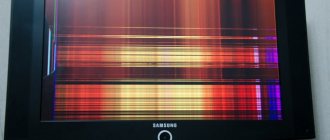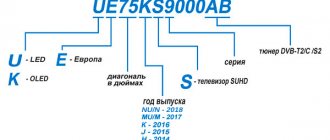When choosing a TV or monitor, regardless of its brand, model, or set of functions offered by the manufacturer, image quality in any case becomes one of the most important criteria. The clarity, brightness and contrast of the “picture”, color accuracy directly depends on the manufacturing technology of the screen matrix. All of them work on liquid crystals and consist of gas-filled cells - pixels. But at the same time, their design and technical capabilities directly depend on the manufacturing technology.
The most commonly installed matrices are IPS and VA. They have different operating principles, properties and costs. In addition, each of the technologies is recommended by experts for solving different problems. This could be viewing photos, watching TV shows, movies, games. Therefore, experts give the answer to the question which matrix is better than IPS or VA individually.
Content:
- 1 LCD
- 2 LED technology
- 3TN
- 4 IPS
- 5VA
- 6 Plasmas
- 7 Where to choose
- 8 Conclusions
All those who have at least once been faced with the choice of a modern TV have heard that the key element is the TV matrix. In this article we will look at the most common types of TV matrices, and also try to figure out which option is optimal. We will talk about systems such as LCD, LED, LCD and plasma TVs.
What is a matrix on a TV? This is a set of thin transparent electrodes located in both planes relative to each other. Visually, the picture is a regular grid with nests.
The matrix is located between glass or film walls. Moreover, the electrodes do not touch each other. It all looks like a regular board with small light bulbs, which together produce an image on the screen.
LCD or LCD displays: IPS, VA or TN matrices. DISASSEMBLY
We stare at screens every day. They all seem to consist of the same color pixels, but why then do different displays have different image quality? What does this depend on?
Let's look at the TV screen under a microscope. We will see the structure of colored pixels. This is the whole secret! Today we are looking into what types of LCD or LCD matrices exist, how they are designed, what features and bonuses they have. And which one is better to choose for your home TV! And why does a TV need a powerful processor?
Spoiler: It will be a Philips TV, but don’t worry, the material is primarily about technology.
LCD operating principle
We know that the image on a TV screen is made up of pixels. But what are the pixels themselves made of? It is very interesting. Look!
If we look at the pixel from the front, we will see 3 color subpixels: red, green and blue. In fact, these are just color filters, and they themselves do not glow, but only color the light. There is a backlight behind the pixel. It illuminates all pixels evenly. At least good lighting makes it even.
But if you illuminate the red, green and blue subpixels equally. The colors will be mixed in equal proportions and we will get just white. And we need millions of different shades. How to get them?
First, you need to learn how to completely block light in each subpixel. How do you think this is being done? Using some kind of curtain that goes down and up? No, much cooler!
Polarizing filters come into play. There are two of them in a pixel, they stand next to each other. First there is a vertical filter, and then a horizontal one. Passing through the first filter, the light seems to be flattened in the vertical direction and becomes polarized in one plane.
And vertically polarized light can no longer pass through a horizontal filter! Profit! We blocked the backlight. But how to unlock it now?
This is exactly why we need a layer with liquid crystals, which give the name to the whole technology. It is located in the very center of the pixel, like in a sandwich: between two polarizing filters. Under the influence of current, the crystals turn and turn the light along with them. And they help him pass in the right amount.
That is, the main task of liquid crystals is to control the intensity of light. All LCD matrices work on this principle, but there are many implementations of it. Hence the different types of matrices: IPS, TN and VA.
TN matrix
The cheapest matrices are TN. In them, liquid crystals are twisted into a spiral that conducts light from a vertical to a horizontal polarizing filter. That's why they are called Twisted Nematic, that is, a twisted nematic crystal.
Such crystals can operate in only two states:
- The twisted state is when 100% of the light passes through
- Chaotic - when light does not pass through.
Accordingly, such matrices are capable of transmitting only a very limited number of colors. Only 6 bits per channel, i.e. 262,144 shades of color. Counts as 2 to the sixth power for the red, green and blue color channels.
And because of this structure, the screens have terrible viewing angles, especially vertically. Therefore, such matrices are practically not used in televisions. But they are used in gaming monitors because they are fast. Remember? There are only two positions in the crystal (on/off), which is why they are fast.
Let's move on. The most common types of matrices found on TVs are VA and IPS. We’re not talking about OLED today; it works on a completely different principle, and these mattresses are very expensive. That's why today there are only residential complexes. Let's start with IPS.
IPS matrices
IPS stands for In-Plane Switching or planar switching. In such matrices, the crystals do not twist relative to each other. They are always lined up. By default, they stand in a horizontal position and do not allow light to pass through.
Unlike TN, in IPS you can adjust the angle of rotation of the crystal and change the amount of light transmitted. This means that you can smoothly adjust the brightness of each pixel.
Therefore, such matrices are perfectly calibrated and are capable of transmitting up to 10 bits per channel. And this already has more than 1 billion flowers - 1.07 billion to be precise.
Also, with this arrangement, the light is better diffused, and this greatly increases the viewing angle. This is why IPS matrices are so respected by professionals working with color.
As a rule, in macro photography of IPS matrices the structure looks unusual - the pixels are located at an angle to each other and it all looks like arrows. Although there are exceptions in the form of such PLS, which are also IPS-like.
But IPS also has serious disadvantages. Firstly, response time. On the first IPS panels it was 50 ms. Now the record is 4 ms, but this is on the most expensive panels. In TN matrices, for example, only 1 ms.
Then in such matrices the distance between the crystals is quite high, which means they do not block the backlight very effectively. Because of this, glare appears and in general the level of black light leaves much to be desired. In IPS matrices, a black screen is more of a mysterious bluish haze.
And if on small smartphone screens, this is not so noticeable. Although... it’s very noticeable to me, thanks - iPhone SE! Then on a large diagonal of 40-50 inches the problem is already clearly evident. Therefore, for televisions, the choice very often falls in favor of another type of matrix. Namely VA.
VA matrices
The crystals in VA matrices, when viewed from the side, are arranged vertically, so VA stands for Vertical Alignment.
But in relation to polarizing filters, liquid crystals are located perpendicular to the filters. In this position, light passes through them without difficulty. Therefore, in terms of black color depth and contrast level, VA matrices are 3 or even 5 times faster than IPS. This is a huge difference, believe me.
But due to the vertical arrangement of the crystals, horizontal viewing angles suffer. If in IPS matrices the viewing angle is somewhere around 178 degrees, in VA this figure is 160.
The second disadvantage of VA matrices. Unlike IPS, VA cannot smoothly adjust the angle of the crystal, which means it is impossible to smoothly adjust the brightness of each subpixel. Therefore, the color rendering quality here is not as good as in IPS matrices.
But it's not all bad. Modern VA matrices are multi-domain. This means that in one subpixel there are several blocks with liquid crystals, which can be controlled separately. This means that each subpixel has several brightness levels. This can be clearly seen from the photographs of VA matrices.
Therefore, modern VAs easily produce 8-bit color. And using FRC (Frame Rate Control) technology, that is, fast pixel blinking, it is possible to achieve an almost honest 10-bit image.
Backlight
A bit complicated? Now let's confuse things even more.
The quality of the image is naturally influenced not only by the quality of the matrix. The next important point is the lighting.
There are two types of Direct-LED - this is when LED bulbs are located over the entire area of the back wall.
And the second type is Edge-LED - when the light comes from one side, usually from below, and the entire screen is illuminated due to a diffuse filter.
Naturally, Direct-LED allows you to make the backlight more uniform. But most importantly, Direct-LED allows you to implement the Local Dimming function, i.e. local disabling of the backlight in dark areas of the frame. Which greatly increases contrast and increases dynamic range. This means it allows you to watch HDR content.
On IPS matrices, the effect of local dimming is less pronounced, so TVs are often paired with Edge-LED backlighting.
But the combination of a good VA matrix and the right backlight gives excellent results. So that you understand, if it is not OLED, a premium TV will usually have a VA matrix installed.
At the same time, VA is an inexpensive technology, so you can also find a good option in the mid-price segment.
Philips 55PUS7303
For example, at our request, Philips sent model 55PUS7303. Why did we ask her? There are three notable things here:
1. In addition to the VA matrix and Direct-LED backlight, Micro Dimming Pro technology is used here. It combines 300 physical backlight local dimming zones and 6,400 software zones that adjust image brightness and contrast depending on the scene and room lighting.
Therefore, in practice, we get a very rich contrast picture without a visible glow effect from the backlight.
By the way, the Philips P5 processor plays a big role in picture quality here. It analyzes the image in real time and pumps it up in every possible way: upscaling, adding frames, if necessary, adjusting the contrast, etc. In TVs, processors really make the difference.
2. Since this is Philips, the Ambilight technology delivers the thrill. You really have to be careful with this thing. Buy Philips once, there may be no going back. With Ambilight, any content looks more voluminous, more impressive and reduces eye fatigue at night!
3. Our favorite - the TV runs on Android TV, so if you want to have a choice of what content to watch and like to customize everything for yourself, there is no competition in this regard.
Distinguishing VA from IPS
Let's return to matrices. When choosing a TV, there is one big nuance to consider. The type of matrix in TVs very often varies from batch to batch. And therefore, the store may not know which matrix is specifically in this instance.
This Philips 55PUS7303 TV model is available in three diagonals - 50, 55 and 65 inches. VA matrices are most often installed in these sizes. But in models with smaller diagonals, IPS is more often found.
Until you look at a specific instance in person, you probably won’t be able to tell which matrix is installed. Therefore, we are sharing with you several life hacks on how to quickly distinguish VA from IPS.
Checking viewing angles. When viewed from the side, VA matrices fade more than IPS. But this is an unreliable method, because... modern VA matrices do not fade that much. Therefore, we offer one more.
If you lightly move your finger across the VA panel, a clear trail of pixels will remain. This effect does not happen on IPS. Just don't press too hard - just lightly. And of course, you can check the black levels. On IPS the black color is blue and not black at all.
And the most hardcore guys can look at the pixel structure if they have a macro lens or a magnifying glass.
Recommendations
The most universal option for the home are TVs with a VA matrix: they have better black levels, backlight uniformity and overall contrast. These TVs are good for both watching and gaming.
However, this cannot be said that IPS is bad. This also has its advantages. If color accuracy is very important to you, or you will often watch TV from a wide angle, take IPS.
But in general, we recommend choosing TVs in person, see what you like best and take it.
And theoretical knowledge will allow you to make a more informed choice. Post Views: 16,240
LCD
This technology is very popular among TV manufacturers. LCD matrices use a viscous liquid (crystal). Electrical voltage causes a synchronous change in the orientation of molecules in space. Due to this, transparency is managed.
Such matrices consist of several components:
- Liquid crystals.
- Transparent electrodes. They are located on both sides and control the ability of the crystals to transmit light.
- Color filter.
- Screen backlight. Located behind the matrix.
- Film or glass. They cover the front part of the matrix.
LED technology
The name of this type of TV matrix is an abbreviation for Light-emmitting diode. Translated into Russian as LED. What does the matrix of this type of LCD TV look like? The difference from the previous technology lies solely in the characteristics of the light supply. Thanks to this approach, it is possible to achieve illumination of each pixel. Accordingly, it is possible to achieve high-quality black color in LED displays and TVs.
Unlike fluorescent lamps, LED lamps do not contain harmful gases and consume noticeably less electricity. Currently, there are two backlight technologies:
- Over the entire surface of the screen. This technology is called Direct. Its use makes it possible to make large screens.
- Around the edges. Thanks to this technology, manufacturers can produce thin displays.
Another main feature of LEDs is their longevity. These TVs last longer than those that use other technologies.
In terms of cost, LED-backlit devices tend to be priced higher than other TVs. But this is quite justified in view of the advantages described above.
In addition to the above, some LCD TV manufacturers offer upgraded types of TV matrices. For example, Samsung actively uses QLED technology. This is a more advanced version of standard LED screens. However, they do not use light filters, but a layer with quantum dots. Conventional filters have one significant drawback. They improve color display quality, but reduce brightness and saturation. QLED technology solves this problem. At the same time, the color structure is not distorted, the image remains bright, and the color palette becomes even wider.
LG is promoting its Nano Cell TV screen technology. Its use allows you to prevent contrast deterioration at large viewing angles and achieve higher picture quality.
As for OLED technology, it is significantly superior to LCD in a number of criteria. Here the source of radiation is the liquid crystals themselves. Almost absolute indicators in color rendering, brightness and response time are achieved. The thickness of modern displays has decreased to 4 mm. Naturally, such advantages are reflected in the price, which is significantly higher than LCD TVs.
What is a TV matrix?
The screen matrix is a block of thin electrodes that are located in different planes - horizontally and vertically. Each individual cell is a pixel.
Simply put, the matrix is microscopic lights, thanks to which the image appears. This is the basis of the screen, which is responsible for color reproduction and image quality.
In the TV industry there are the following matrix production technologies:
- Plasma panels - current passes through gas and emits light.
- LCD – liquid crystal screens. In its pure form, this technology is practically no longer used.
- LED – LCD panels with LED backlighting, but its type also varies.
- OLED is a system with the best picture quality that runs on organic light-emitting diodes. This technique is quite expensive.
- QLED is a quantum dot technology that is a direct competitor to OLED as it produces clear, detailed and bright images.
TN
This type of LCD matrix for TVs is no longer manufactured. It was replaced by TN-Film. Despite the fact that this solution makes it possible to convey dynamic scenes on the screen much more efficiently, there are problems with both color rendering (it is 20% lower) and the viewing angle (the maximum value is up to 160 degrees). One of the main advantages of such matrices is their low price, as well as energy savings.
The name of the technology comes from two English words - Twisted Nematic (twisted nematic crystal). In this technology, the elements are arranged in cells in the form of a spiral.
What to choose - glossy or matte display?
It remains to consider the question of which screen is better - matte or glossy for a TV, and why. Here the choice depends on the place in the apartment where the equipment will be hung, and personal feelings. On gloss, the picture looks bright and clear. Matte displays create a hazy effect that can be unpleasant on the eyes. But in bright rooms where there is a lot of sunlight (especially towards equipment), it is more comfortable to watch TV with a matte monitor. There is less glare on its surface, which means less distortion.
It is quite difficult to give a definite answer to the question which TV screen is better . After all, when choosing, the size of the monitor, the budget, personal perceptions, the purpose of the equipment, and even the room in which it will be used are of great importance. But if the quality of the reproduced picture and the feeling of viewing dynamic scenes is important, you should take a closer look at LCD LED or OLED options.
IPS
These types of LCD matrices are developed by the famous Hitachi brand. Subsequently, companies such as Samsung and LG drew attention to IPS. The name itself is translated from English as switching in planes. The technology has a number of significant advantages compared to TN. It is often used in the manufacture of televisions. The advantages of this particular solution include a large viewing angle, higher quality color rendering (when compared with TN technology, where, as we remember, only 80% is transmitted).
However, this technology also has its certain disadvantages. These include lower response speed and the presence of pixelation in TVs with a small diagonal. The price of models with this technology is higher than that of TN TVs.
Visual inspection of matrix types to identify technology
A common method is to display a pure white image on the TV screen. And take a picture with your phone of a small section of this matrix at a distance of approximately 5 millimeters
from the screen surface. This will produce an image of the grid that can be enlarged on your phone screen.
So, for example, the visual difference in the matrices of RGB and RGBW TVs from LG can be seen in the presence of an additional white subpixel in the RGBW matrices.
This option for identifying the matrix is not always optimal, since visual inspection of the matrix without a microscope does not always allow one to accurately determine its type.
Instead, you can look at the TV you want from an angle. If the TV uses a TN matrix, then when you look at it from the side, the image on it will darken and the color display will be distorted. For the VA matrix type, the shades will become lighter, but for the IPS matrix, nothing will change in the display of colors.
Also, the presence of IPS can be signaled by a purple tint of the screen when looking at an angle at a black screen.
If there are damaged (broken) pixels in the matrix, then they will appear black in the IPS matrix. For a TN matrix they will be white.
V.A.
The name of this technology is an abbreviation of two English words Vertical Alignment, which can be translated as vertical alignment. Its creators are engineers from Fujitsu. True, almost immediately after its appearance, the technology began to be used by other manufacturers.
The technological solution differs from IPS and TN in that there are no spirally twisted elements. The light does not go beyond the liquid crystals. The advantages of this solution include a high level of contrast, richer and deeper colors, high color rendering and a natural palette.
As for the disadvantages, they are also present and these include color changes even at small viewing angles. By the way, this problem was solved a few years after the technology appeared. The successor to VA is MVA, where the viewing angle has been increased with all the advantages of the basic solution.
Plasma
The technology is based on the glow of a phosphor heated by ultraviolet rays. Each individual element is a light source. Moreover, it does not depend on other elements. Accordingly, there is no need for backlighting. The main manufacturers of TVs using this technology are companies such as LG, Panasonic and Samsung.
The advantages of plasma panels include high quality color rendering and depth, as well as the presence of a three-dimensional two-dimensional effect. In addition, plasmas have high-quality black color and excellent display of dynamic content. TVs with this technology have minimal response time and maximum viewing angles.
The disadvantages include the presence of a residual image (that is, the panel will not work normally with the computer), poor display of static backgrounds and high energy consumption.
What to choose
So which matrix should you choose for your TV? Before buying a TV, you need to pay attention to two important aspects - cost and your needs. The market offers both budget options with TN matrices and more expensive models. TVs with a TN-Film matrix have no more than 32 inches diagonally. This option is an ideal solution for small rooms or cottages. Also, TVs with this technology are often used for computer games.
If you want better display quality, it's worth looking at LCD technologies such as VA or IPS. Most modern manufacturers use them for their latest models. TVs with such matrices have an almost unlimited viewing angle. True, VAs are slightly inferior in image quality, but they are also cheaper.
Well-known brands in the field of TV production mainly use IPS and VA. For example, Toshiba works with the first type of matrices. And Sony, Panasonic and Sharp are refining VA technology, bringing it to perfection.
The vast majority of TV devices from brands such as LG or Samsung contain VA matrices. Samsung offered its own modification of S-PVA. The technology can be found in TVs in the more expensive segment. The technological solution significantly increases the viewing angle and allows for more saturated black color.
You can't do without borrowing. The recognizable Phillips brand uses technologies developed by LG and Samsung in its TVs.
More details about the types of LCD displays
The first liquid crystal TVs were called LCD. Due to low power consumption and light weight (even when purchasing a TV with a diagonal size of 80 inches), they immediately became in demand. Therefore, manufacturers began to experiment with the design of the LCD layer in order to maximize the quality of the picture - make it bright, contrasty, and clear. This is how subtypes of liquid crystal monitors appeared. To make it easier to choose the best option, we will consider all these types of TV screens and their operating features.
LCD CCFL and EEFL displays
This type of monitor uses Cold Cathode Fluorescent Lamp (CCFL) as a light source. An ordinary fluorescent lamp emits a stream of white rays.
Due to the use of a conventional lighting device, the thickness of the (albeit flat) monitor is not much different from plasma technology. But the image quality is yes.
The use of fluorescent lamps as a light source does not allow local dimming of an area of the monitor. You cannot increase the brightness of the neighboring one. This is because the type of backlight chosen does not make it possible to highlight only, for example, one pixel on a black background. The lamp illuminates the entire area of the layer. Hence the low image contrast of the first models of LCD technology.
LCD TV display types with External Electrode Fluorescent Lamp (LCD EEFL) had similar quality of the reproduced image (for the same reason).
The light source with external electrodes is a fluorescent lamp. Cold plasma backlight also does not allow increasing the brightness of a single zone.
LCD LED displays
At the beginning of the 21st century, ice lighting began to be actively used. Liquid crystal direct TV LCD LED (Light-Emitting Diod) are enormously different from previous types of technology:
- very light, thin TV case (size in the range of 2-3.5 cm);
- spot illumination, which improved the contrast of the picture by 75%;
- adjustable brightness of individual monitor zones;
- improved color rendering;
- even lower energy consumption (by 34-40%);
- good viewing angle (curved bodies appeared).
Answering the question which TV screen technology is better , experts unanimously say LCD LED.
Their cost is slightly higher than the first two types of equipment, but due to the resistance of LEDs to loads (long service life), as well as reduced energy consumption, the purchase quickly pays for itself.
conclusions
Choosing a matrix is not a difficult task if you understand what kind of price-quality ratio you want to get in the end and if you are familiar with its characteristics. Before purchasing, be sure to find out what matrix is installed in the TV or monitor. If you are not completely sure, there are several ways to check and determine this. The market offers both cheaper options with lower quality and premium TV models using advanced technologies in the manufacture of matrices.
Found a mistake? Select it and press ctrl+enter
- 60
Take a closer look at the serial number to determine the matrix
First of all, we recommend that you examine the serial number of your TV. For many manufacturers you can find matrix type codification in the serial numbers of their TV.
The TV model number may contain information about the type of matrix installed in it
So, for example, the first two letters of the serial number of Samsung TV models contain information about the type of matrix used. In the 2021 Samsung TV model code QN65Q900RBFXZA, the letters QN indicate the QLED matrix type (the term Samsung uses for the commercial name for its new LED LCD-based monitors).
Take a closer look at the serial number, and it is quite possible that you will see references to TN, TFT, IPS and others without any hidden codifications, like Samsung.
The serial number can be found on the TV itself (usually on the back), on the TV box. And also in the menu item of the TV itself, where there is an item with information about the TV itself.











